Exercise Progressions for Resuming Strength Training Following Posterior-Chain Muscle Injury
by Emidio E. Pistilli, PhD
NSCA Coach
June 2025
Vol 11, Issue 4
The purpose of this article is to provide a sample training program that targets the posterior chain of the lower limb and allows athletes to gain pain-free range of motion.
INTRODUCTION
The posterior chain of the lower limb has received and continues to receive considerable focus in the training programs of athletes (1,2,9,11). The muscles that comprise the posterior chain are extensively utilized in sprinting and jumping activities. Injury rates can be high in athletes, and the time to rehabilitate and return to competition can be extensive (4,8). Focused training of the posterior chain to limit the potential for injury and to rehabilitate the area after injury should receive attention in the training plan of athletes. The purpose of this article is to provide a sample training program of progressions for selected exercises that target the posterior chain of the lower limb and allow the athlete to progressively acquire pain-free range of motion. The main determinant for moving through the exercise progressions is pain in the hip, gluteal muscles, and hamstring muscles. By only moving through a pain-free range of motion, the athlete can begin to acquire strength in the targeted area. Athletes then move through the progressions to slowly increase pain-free range of motion. Athletes should always ensure that training, including the program presented here, is only implemented after receiving clearance by an athletic trainer or other medical professional.
The posterior chain of the lower limb is comprised of the gluteal muscle group, hamstrings muscle group, gastrocnemius muscles, soleus muscles, spinal erectors, and latissimus dorsi (6,7). These muscles are involved in hip extension, knee flexion, ankle plantarflexion, and back extension (6,7). The muscles that extend the spinal column consist of several overlapping muscles with varying origins and insertions that run along the spinal column. The largest muscle group based on mass in the back is the erector spinae group, consisting of three sub-groups of overlapping muscles: the iliocostalis group, longissimus group, and spinalis group. Within these sub-groups, not all muscles contribute to extension of the spinal column. The main erector spinae muscles that contribute to extension of the spinal column are: iliocostalis lumborum, longissimus thoracis, spinalis thoracis, spinalis cervicis, and spinalis capitis. Additionally, the iliocostalis thoracis assists in maintaining an erect position of the spinal column. Additional contributions to spinal column extension come from muscles of the transversospinalis group (semispinalis thoracis, semispinalis cervicis, semispinalis capitis, multifidus, and rotators), and the interspinales muscles of the segmental group (12). If the upper back is held constant in an isometric contraction with movement only at the hips, then these spinal column muscles would contribute more to stabilizing the torso than in actual spinal extension. As athletes begin this program, it is important to understand that individual anthropometrics (e.g., hip osteology, body segment lengths, etc.) may limit exercise technique. In the following exercises progressions, ranges of motion and specific joint angles are provided for reference only and are not intended as exercise requirements.
EXERCISE PROGRESSION: DEADLIFT
The goal of this progression is to gradually increase the range of motion of the deadlift exercise, as the starting position moves from above the knee to the floor. The angle of the torso with the floor will progressively decrease, which will serve to lengthen the hamstring muscles passively before the start of each concentric contraction. Once the athlete can perform an exercise in a pain-free range of motion, they can move to the next exercise in the progression. Resistance on the bar should be minimal, as the purpose is to move through the exercise progression and, therefore, begin each exercise with a greater starting length of the hamstring muscles (i.e., smaller hip angle). Athletes can also consider performing these movements without a barbell (i.e., bodyweight) or with dumbbells until adequate strength and pain-free range of motion is acquired.
DEADLIFT FROM ABOVE THE KNEE (VARIANT 1)
The first exercise in the deadlift progression is the deadlift from above the knee (Figure 1). The barbell should be set on blocks or stands such that the bar rests just above the knee joint when the athlete is in the starting position (Figures 1A and 1B). In the starting position, the hips will be flexed at an angle of approximately 110°, and the shoulders should be in front of the bar. From this starting position, the athlete will perform the concentric movement and finish in a standing position with the barbell at hip-height. As seen in Figure 1C, the range of motion of this exercise is very small. The athlete will slowly lower the barbell back to the starting position and repeat for the prescribed number of repetitions.
DEADLIFT FROM BELOW THE KNEE (VARIANT 2)
The second exercise in the deadlift progression is the deadlift from below the knee (Figure 2). The barbell should be set on blocks or stands such that the barbell rests just below the knee joint, in line with the tibial tuberosity, when the lifter is in the starting position (Figures 2A and 2B). In the starting position, the hips will be flexed at an angle of approximately 80°, and the shoulders should be in front of the bar. From this starting position, the athlete will perform the deadlift movement, finishing in a standing position with the barbell at the level of the hips and moving through a greater range of motion (Figure 2C). The athlete will slowly lower the barbell back to the starting position and repeat for the prescribed number of repetitions.
DEADLIFT FROM THE FLOOR (VARIANT 3)
The third exercise in the deadlift progression is the deadlift from the floor (Figure 3). The barbell should be set on the floor with weight plates or stands such that the barbell rests mid-way between the knee joint and the ankle joint when the athlete is in the starting position (Figures 3A and 3B). In the starting position, the hips will be flexed at an angle of approximately 50°, and the shoulders should be in front of the bar. From this starting position, the athlete will perform the deadlift movement, finishing in a standing position with the barbell at the level of the hips and moving through an increased range of motion (Figure 3C). The athlete will slowly lower the barbell back to the starting position and repeat for the prescribed number of repetitions.
DEFICIT DEADLIFT FROM THE FLOOR (VARIANT 4)
The final exercise in the deadlift progression is the deficit deadlift from the floor (Figure 4). The barbell should be set on the floor with weight plates such that the barbell is just above the ankle joint. To achieve this starting position, the athletes stand on weight plates (Figures 4A and 4B). In the starting position, the hips will be flexed, the torso will be approximately parallel with the floor, and the shoulders should be in front of the bar. From this starting position, the athlete will perform the deadlift movement, finishing in a standing position with the barbell at the level of the hips and moving through an increased range of motion (Figure 4C). The athlete will slowly lower the barbell back to the starting position and repeat for the prescribed number of repetitions.
EXERCISE PROGRESSION: GOOD MORNING
The goal of this progression is not necessarily to increase the range of motion of the good morning exercise; instead, this progression aims to perform the different versions of the good morning exercise that require progressively greater torso and hip stabilization. Whereas the deadlift progression exercises could be performed with a concentric-only contraction from the starting position, the good morning exercise requires an eccentric contraction followed by the concentric contraction. Therefore, the resistance on the barbell should be minimal and the focus on performing pain-free movement patterns. Once the athlete can perform an exercise in a pain-free range of motion, they can move to the next exercise in the progression. In general, the range of motion of the good morning is limited, and athletes should be cautioned to not round the back or introduce excessive forward lean during the eccentric portion of the movement.
GOOD MORNING SEATED ON A BENCH (VARIANT 1)
The first exercise in the good morning progression is the good morning seated on a bench (Figure 5). In the starting position, the athlete will sit on the end of a bench, with the torso upright and a barbell resting along the trapezius and deltoid muscles (Figure 5A). The athlete will perform an eccentric contraction of the erector spinae and hamstring muscles, while lowering the torso until it is approximately parallel to the floor (Figure 5B and 5C). The athlete will then reverse the motion by performing a concentric contraction and returning to the starting position. Repeat the movement for the prescribed number of repetitions.
KNEELING GOOD MORNING (VARIANT 2)
The second exercise in the good morning progression is the kneeling good morning (Figure 6). In the starting position, the athlete will kneel on the ground, with the torso upright and a barbell resting along the trapezius and deltoid muscles (Figure 6A). The athlete will perform an eccentric contraction of the erector spinae and hamstring muscles, while lowering the torso until it is approximately 30 – 45° to the floor (Figure 6B and 6C). This exercise will require greater stabilization of the torso, which can be facilitated by moving the hips backward and reestablishing a new center of mass. The athlete will then reverse the motion by performing a concentric contraction, moving the hips forward and returning to an upright position. Repeat for the prescribed number of repetitions.
STANDING GOOD MORNING (VARIANT 3)
The third exercise in the good morning progression is the standard good morning (Figure 7). In the starting position, the athlete will stand with the torso upright and a barbell resting along the trapezius and deltoid muscles (Figure 7A). The athlete will perform an eccentric contraction of the erector spinae and hamstring muscles, while lowering the torso until it is almost parallel to the floor (Figure 7B and 7C). This exercise will require stabilization of the torso, which can be facilitated by moving the hips backward and reestablishing a new center of mass. The athlete will then reverse the motion by performing a concentric contraction, moving the hips forward and returning to an upright position. Repeat for the prescribed number of repetitions.
GOOD MORNING SEATED ON THE FLOOR (VARIANT 4)
The final exercise in the good morning progression is the good morning seated on the floor (Figure 8). In the starting position, the athlete will sit on the floor with the torso upright and the legs abducted with a barbell resting along the trapezius and deltoid muscles (Figures 8A and 8B). The athlete will perform an eccentric contraction of the erector spinae and hamstring muscles, while lowering the torso until it is approximately 30 – 45° to the floor (Figure 8C and 8D). Resistance on the barbell should be minimal with this exercise, as the motion will require a significant eccentric stretch of the hamstrings and hip musculature. Before utilizing a barbell, athletes can utilize bodyweight or PVC pipes during this variant, as a way to minimize loading and increase the range of motion. The athlete will then reverse the motion by performing a concentric contraction and returning to an upright position. Repeat for the prescribed number of repetitions.
An advanced modification of the good morning exercise is to perform the standing good morning and finish the movement with either a standing calf raise or a vertical jump (10). The addition of the vertical jump variation should occur when the athlete is able to complete the entire good morning progression in a pain-free range of motion. Adding the vertical jump to the good morning exercise brings the movement closer to the muscle actions that would occur in the performance of the snatch and clean (3). The snatch and clean is a relatively slow eccentric movement, changing directions into a concentric movement that gains speed and finishes with an explosive triple extension of the hips, knees, and ankles (3). Triple extension, which occurs at the end of the second pull of the snatch and clean, is the point of the exercises associated with the greatest power output (9). Therefore, performance of this good morning modification in a pain-free range of motion would signal that the athlete is ready to begin performing more power-associated exercises (e.g., snatch, clean, weightlifting derivatives).
EXERCISE PROGRESSION: ROMANIAN DEADLIFT (RDL)
The goal of this progression is to increase the resistance that can be used in a pain-free range of motion during the RDL exercise. When comparing the good morning and RDL exercises, the motions are very similar, with extension occurring at the hips during the concentric contraction. Like the good morning exercise progression, the RDL progressions require an eccentric contraction followed by the concentric contraction. The resistance used during the RDL exercise will be different because the weight is held in the hands instead of across the trapezius and deltoids. The range of motion can be adjusted by utilizing a clean grip or a snatch grip. Once the athlete can perform an exercise in a pain-free range of motion, they can move to the next exercise in the progression.
CLEAN GRIP RDL (VARIANT 1)
The first exercise in the RDL progression is the RDL performed with a clean grip (Figure 9). In the starting position, the athlete will stand while holding the barbell with a shoulder-width grip, similar to the hand spacing used during the clean exercise (i.e., clean grip). This will have the barbell just below the hips in the starting position (Figures 9A and 9B). The athlete will perform hip flexion consisting of an eccentric contraction of the erector spinae and hamstring muscles, while lowering the torso until it is approximately at a 30° angle with the floor (Figure 9C). Importantly, the barbell will remain close to the thighs during the eccentric movement, which will end when the barbell reaches the tibial tuberosity just below the kneecap (Figure 9D). The athlete will then reverse the motion by performing a concentric contraction and returning to the starting position. Repeat for the prescribed number of repetitions.
SNATCH GRIP RDL (VARIANT 2)
The second exercise in the RDL progression is the RDL performed with a snatch grip (Figure 10). In the starting position, the athlete will stand while holding the barbell with the hands wider than shoulder width, similar to the hand spacing used in the snatch exercise (i.e., a wide snatch grip). This will have the barbell just below the waist and in line with the hips in the starting position (Figures 10A and 10B). The athlete will perform an eccentric contraction of the erector spinae and hamstring muscles, while lowering the torso until it is approximately at a 10° angle with the floor (Figure 10C). Importantly, the barbell will remain close to the thighs during the eccentric movement, which will end when the barbell reaches the tibial tuberosity just below the kneecap (Figure 10D). The athlete will then reverse the motion by performing a concentric contraction and returning to the starting position. Repeat for the prescribed number of repetitions.
EXERCISE PROGRESSION: NORDIC HAMSTRING CURL
The goal of this progression is to develop eccentric-reactive strength of the posterior chain muscles. This can be accomplished by utilizing a gradual movement of the partner’s hand placement, moving from right behind the knee to the ankles. As this length increases, the effort of the exercise will increase. Research suggests that the Nordic hamstring curl induces the highest electromyographic (EMG) activity within the hamstrings group, compared to other hamstring exercises (5). Therefore, this exercise is one that should be included toward the end of the rehabilitation program, when the athlete has worked through the above four progressions and gained strength and pain-free range of motion. This progression starts with the partner’s hands directly behind the athlete’s knees (variant 1: Figures 11A and 11B), followed by the partner’s hands directly over the gastrocnemius muscles (variant 2: Figures 11C and 11D) and finally the partner’s hands directly on the ankles (variant 3: Figures 11E and 11F). Once the athlete can perform an exercise in a pain-free range of motion, they can move to the next exercise in the progression. This exercise can also be performed without a partner if specialized equipment is available to enable the movement pattern (e.g., glute-ham machine, NordBord™).
CONCLUSION
This training program is designed to assist athletes in resuming strength training following injury to any of the muscles that comprise the posterior chain in the lower limbs. In the sample program depicted in Table 1, the athlete would begin with the first variant of the deadlift, good morning, and RDL exercises. Progression through the variants occurs based on the perception of pain and the ability to acquire a greater range of motion. Weekly sessions can be repeated until the proper range of motion is attained. For example, the deadlift variant 2 is suggested for week 2, which requires a greater range of motion compared to variant 1. After two sessions, if the athlete continues to feel discomfort toward the end of the range of motion of deadlift variant 2, the suggested exercises can be repeated for an additional week. In addition, the suggested repetitions for each exercise can be reduced to allow for pain and muscle fatigue. In the situation that repetitions are lowered, exercises can be repeated for additional weeks as the athlete works toward the target number of repetitions. The program is intended to be adaptable in terms of exercise selection and training volume as athletes progress. Note that the Nordic hamstring curl is not recommended until at least three weeks of training through the progression of the first three exercises. Furthermore, the authors recommend assistance on the concentric phase of this exercise until adequate strength is developed. Completion of these exercise progressions should allow an athlete to resume pre-injury strength training and sport-specific training activities.

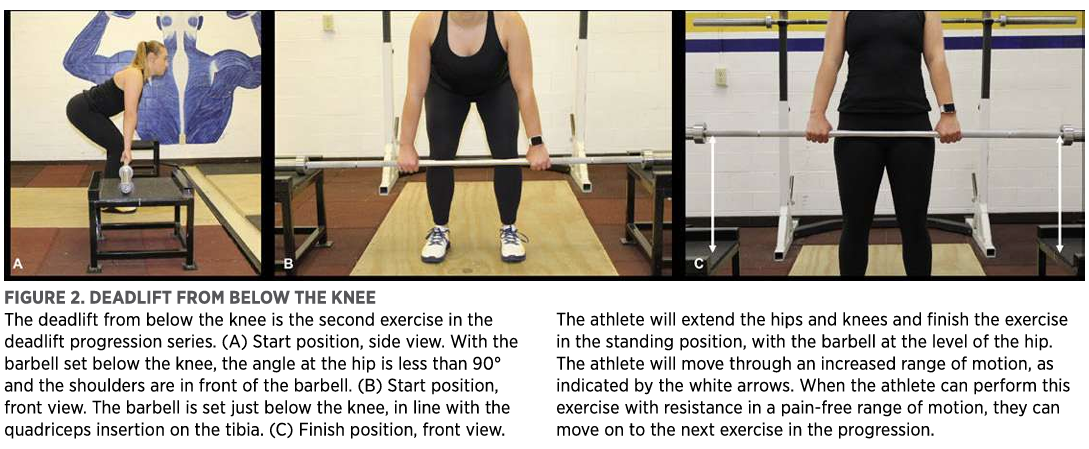
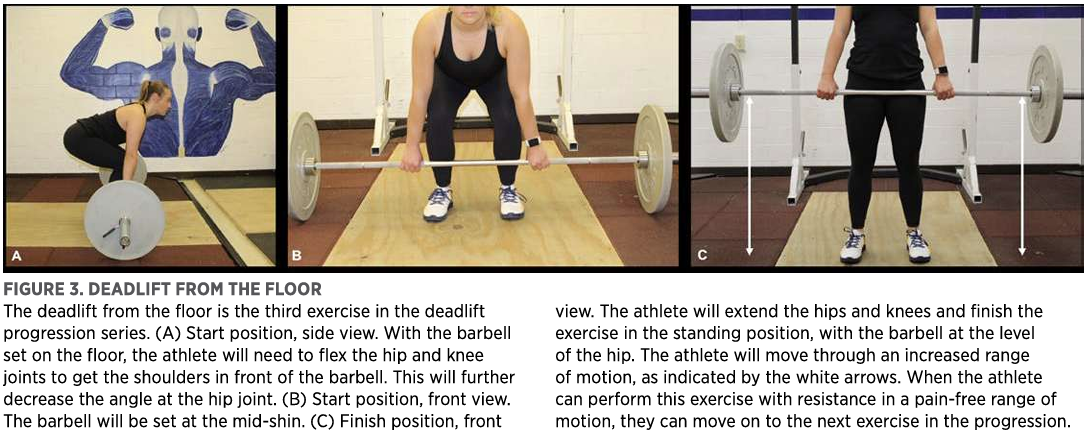

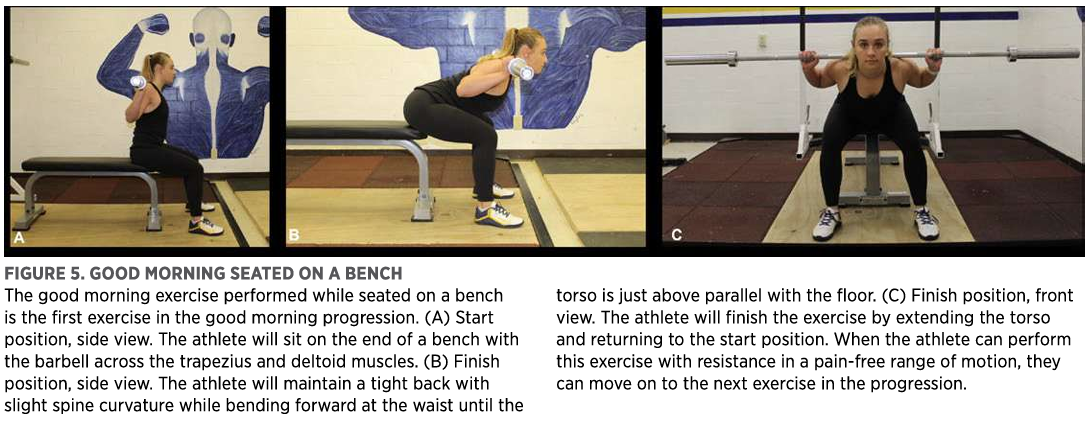
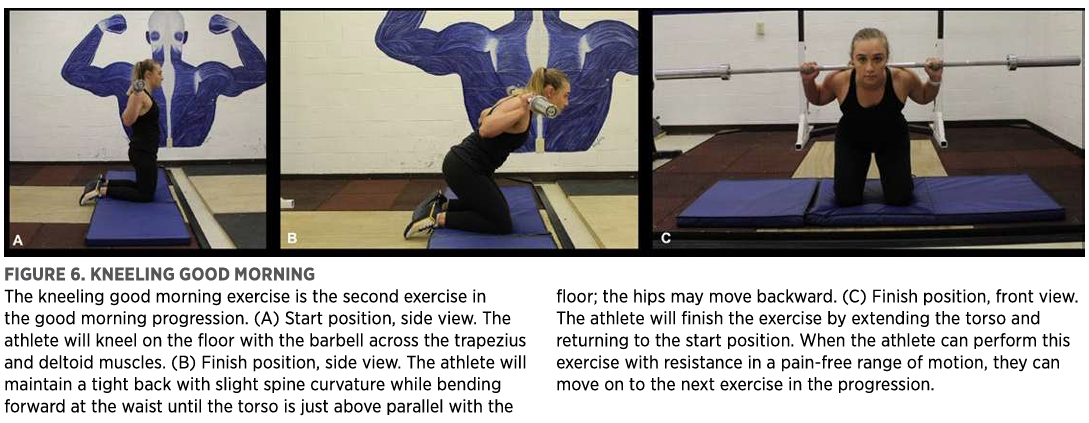
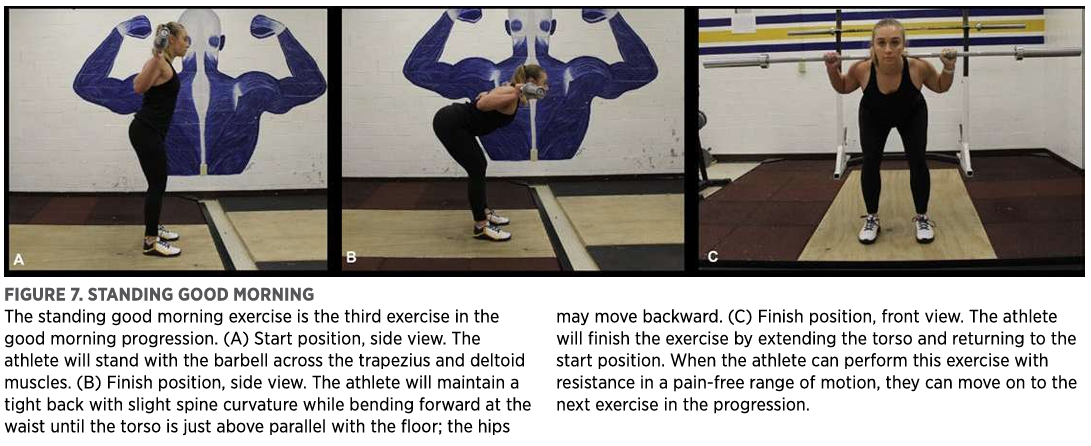
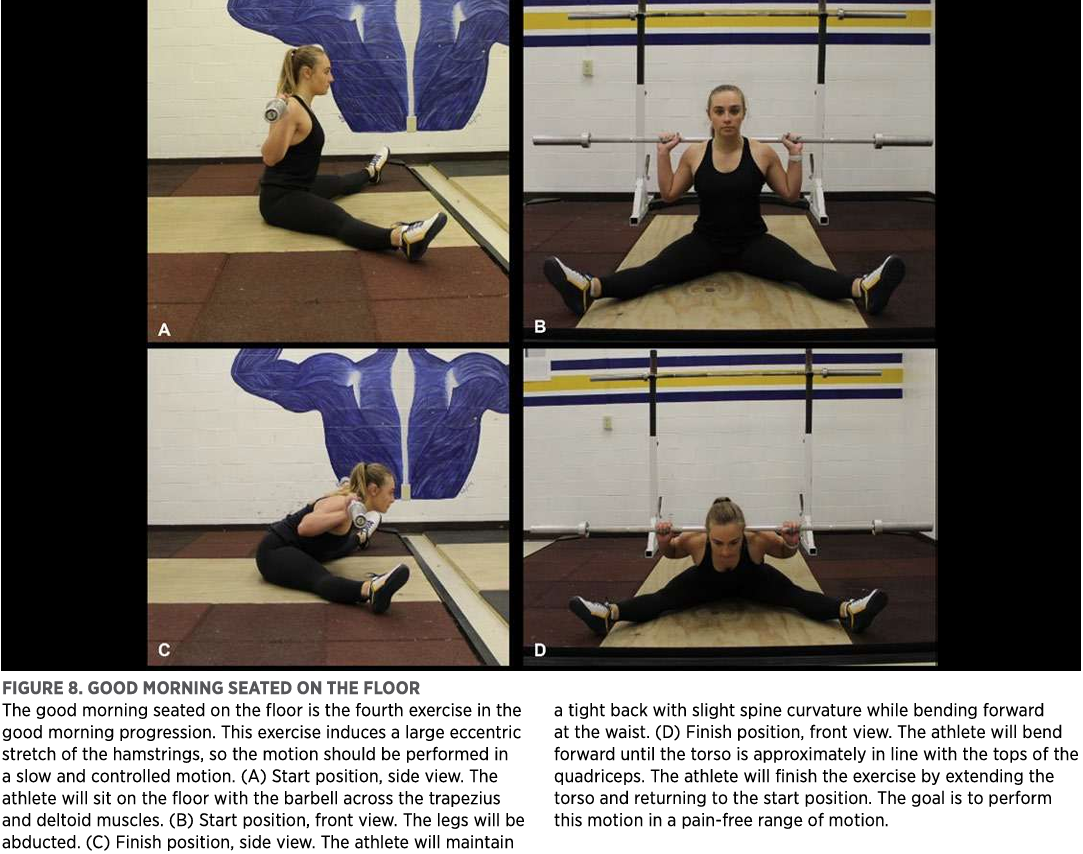

This article originally appeared in NSCA Coach, a quarterly publication for NSCA Members that provides valuable takeaways for every level of strength and conditioning coach. You can find scientifically based articles specific to a wide variety of your athletes’ needs with Nutrition, Programming, and Youth columns. Read more articles from NSCA Coach »
Related Reading
Chang, E, Norcross, MF, Johnson, ST, Kitagawa, T, and Hoffman, M. Relationships between explosive and maximal triple extensor muscle performance and vertical jump height. Journal of Strength and Conditioning Research 29: 545-551, 2015.
Lorenz, D. Facilitating power development in the recovering athlete: Triple extension in rehabilitation. Strength and Conditioning Journal 38: 48-50, 2016.
REFERENCES
- Alonso-Fernandez, D, Docampo-Blanco, P, and Martinez-Fernandez, J. Changes in muscle architecture of biceps femoris induced by eccentric strength training with nordic hamstring exercise. Scandinavian Journal of Medicine and Science in Sports 28: 88-94, 2018.
- Chang, E, Norcross, MF, Johnson, ST, Kitagawa, T, and Hoffman, M. Relationships between explosive and maximal triple extensor muscle performance and vertical jump height. Journal of Strength and Conditioning Research 29: 545-551, 2015.
- Charniga, A. Variations and rational use of the good morning exercise. NSCA Journal 8: 74-77, 1986.
- Ekstrand, J, Bengtsson, H, Walden, M, Davison, M, Khan, KM, and Hagglund, M. Hamstring injury rates have increased during recent seasons and now constitute 24% of all injuries in men’s professional football: The UEFA Elite Club Injury Study from 2001/02 to 2021/22. British Journal of Sports Medicine 57: 292-298, 2022.
- Ferri-Caruana, A, Molla-Casanova, S, Baquedano-Moreno, M, and Serra-Ano, P. Electromyographic activity of posterior kinetic chain muscles during hamstring strengthening exercises. Physical Therapy in Sport 55: 205-210, 2022.
- Gabriel, A, Konrad, A, Herold, N, Horstmann, T, Schleip, R, and Paternoster, FK. Testing the posterior chain: Diagnostic accuracy of the bunkie test versus the isokinetic hamstrings/quadriceps measurement in patients with self-reported knee pain and healthy controls. Journal of Clinical Medicine 13, 2024.
- Hardeman, A, Serrano, J, Serrano, B. The importance of the posterior chain in crossfil programming. British Journal of Medical and Health Sciences 2: 582-589, 2020.
- Hughes, R, Cross, M, Stokes, K, Tobin, D, Power, E, et al. Novel biomechanical injury risk score demonstrates correlation with lower limb posterior chain injury in 50 elite-level rugby union athletes. BMJ Open Sport and Exercice Medicine 7: e001062, 2021.
- Lorenz, D. Facilitating power development in the recovering athlete: Triple extension in rehabilitation. Strength and Conditioning Journal 38: 48-50, 2016.
- Siff, MC. Supertraining. Denver, CO: Supertraining Institute; 2004.
- Tataryn, N, Simas, V, Catterall, T, Furness, J, and Keogh, JWL. Posterior-chain resistance training compared to general exercise and walking programmes for the treatment of chronic low back pain in the general population: A systematic review and meta-analysis. Sports Medicine Open 7: 17, 2021.
- Tortora, GJ, and Grabowski, SR. Principles of Human Anatomy and Physiology. New York, NY: Harper Collins College Publishers; 1993.
Learn about the benefits of NSCA Membership »
- Privacy Policy
- Your Privacy Choices
- Terms of Use
- Retraction and Correction Policy
- © 2025 National Strength and Conditioning Association